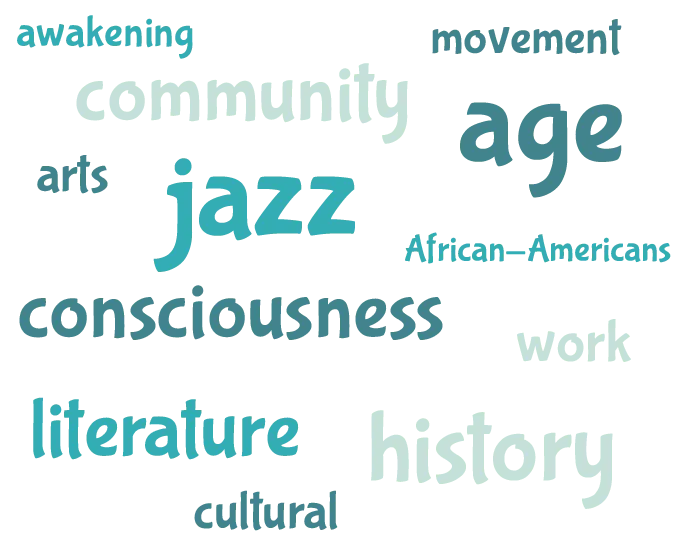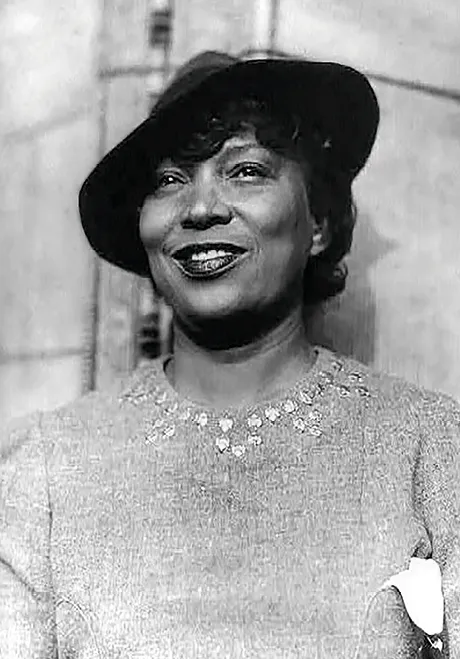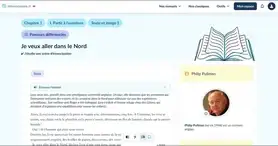Unit 4
Bac
Exam file
Préparation aux évaluations communes
Ressource affichée de l'autre côté.
Faites défiler pour voir la suite.
Faites défiler pour voir la suite.
Évaluations communes
1H30Ressource affichée de l'autre côté.
Faites défiler pour voir la suite.
Faites défiler pour voir la suite.
Compréhension de l'oral Overview of The Harlem Renaissance
1
Avant l'écoute Lisez le titre ci-dessus et regardez le nuage de mots.
a. Sur quoi peut porter cet enregistrement ? Faites trois hypothèses.
b. Trouvez cinq autres mots que vous pourriez entendre dans l'enregistrement.
2
Après l'écoute En rendant compte, en français, du document, vous montrerez que vous avez compris les éléments suivants :
- Le thème principal du document ;
- À qui s'adresse le document ;
- Le déroulement des faits, la situation, les événements, les informations ;
- L'identité des personnes ou des personnages et, éventuellement, les liens entre elles / entre eux ;
- Les éventuels différents points de vue ;
- Les éventuels éléments implicites du document ;
- La fonction et la portée du document (relater, informer, convaincre, critiquer, dénoncer, etc.).
Ressource affichée de l'autre côté.
Faites défiler pour voir la suite.
Faites défiler pour voir la suite.
Overview of The Harlem Renaissance, About.com, 2018.
Ressource affichée de l'autre côté.
Faites défiler pour voir la suite.
Faites défiler pour voir la suite.


Ressource affichée de l'autre côté.
Faites défiler pour voir la suite.
Faites défiler pour voir la suite.


Ressource affichée de l'autre côté.
Faites défiler pour voir la suite.
Faites défiler pour voir la suite.
Expression écrite
Choisissez un sujet et répondez-y en anglais en 120 mots minimum.
Imagine that you are Bob and answer Davy's letter from Manhattan. Write the letter.
Would you like to live in the 20s? Why or why not?
With a classmate, you have to make a presentation about a topic related to the Roaring 20s. Convince your partner to include this video about the Harlem Renaissance. Imagine your dialogue.
Sujet A - Texte ci-dessus
Imagine that you are Bob and answer Davy's letter from Manhattan. Write the letter.
Sujet B - et
Would you like to live in the 20s? Why or why not?
Sujet C -
With a classmate, you have to make a presentation about a topic related to the Roaring 20s. Convince your partner to include this video about the Harlem Renaissance. Imagine your dialogue.
Ressource affichée de l'autre côté.
Faites défiler pour voir la suite.
Faites défiler pour voir la suite.
- Inspirez-vous des documents étudiés dans l'unité.
- Respectez la forme de la lettre.
- Sujet B : Appuyez-vous sur les documents pour formuler vos réponses.
Ressource affichée de l'autre côté.
Faites défiler pour voir la suite.
Faites défiler pour voir la suite.
Compréhension de l'écrit
Davy Carr writes a letter to Bob Fletcher, a friend in Harlem.
Dear Bob,
I am glad you found my last letter entertaining. It surely was long, and I feared it might be tedious. Life has many charms hereabouts, socially speaking. I miss the theater, of course, and envy you your opportunities on the little old island of Manhattan. When I look over the Sunday edition of the New York Times, and note the theatrical page, I could weep. The downtown theaters here segregate colored people, and some of them will not sell them seats anywhere but in the gallery. Naturally, that lets me out. You will say, of course, that since I can "get by", such a rule should not bother me. But for some reason difficult to explain, it does. Needless to relate, scores of folks here go to the theater whenever they want to, and sit where they please, and no one notices them. Who, indeed, can blame them?
And that brings me to a question which has interested me very much, the existence of color lines within the color line. It is a very fascinating subject, and one on which I am going to write someday, for nothing that I have seen in print thus far seems to do the theme anything like justice. Then, too, the whole face of the matter is undergoing ceaseless transformations, as might be expected. The complexity of our social life is amazing. It makes one think of the kaleidoscopes we used to have when I was a very small boy. As you looked through them, the colors and forms changed moment by moment. To my mind, and I speak, as you well know, from a varied experience, this town presents a better opportunity for the study of this question of color lines within the race group than any city in America, so I am keeping eyes and ears open.
But to return to the party itself. The Wallaces, so Reese said, would come for me shortly after three Saturday. So about three-thirty they arrived, bringing with them the Hales. The ride out was delightful in the bracing October chill. And our party was a merry one. Mrs. Hale was strikingly handsome, with her rosy cheeks and dark hair, Mrs Wallace was as jolly as could be, and Wallace is always the best of company. [...]
The bungalow, as they called it, was after all not a bungalow at all, for it was a tiny two-story affair, with a wide veranda covering the front of both floors. Downstairs there was a tiny kitchen and a pantry, and a small front room with an open grate; and upstairs one bedroom and a big sleeping porch. We sat on the lower porch and waited a few minutes for our host, who brought Miss Barton with him in his very trim roadster, and he was followed immediately by the Morrows, who brought with them someone of whom we have heard more than once from Marcia. I refer to the friend Donald Verney. He is an interesting-looking fellow, surely. He may be a trifle older than Wallace, but he was such a youthful manner that it is hard to guess his age. He is a little above the medium height, fair, yet with a kind of ruddy brownness, good features, and keen eyes. He seems to be a general favorite, is a lively talker when the mood takes him, and a very good storyteller. Altogether, it was about as lively a crowd of reasonable mature people as I have ever seen.
Washington, D.C., October 9, 1922
Dear Bob,
I am glad you found my last letter entertaining. It surely was long, and I feared it might be tedious. Life has many charms hereabouts, socially speaking. I miss the theater, of course, and envy you your opportunities on the little old island of Manhattan. When I look over the Sunday edition of the New York Times, and note the theatrical page, I could weep. The downtown theaters here segregate colored people, and some of them will not sell them seats anywhere but in the gallery. Naturally, that lets me out. You will say, of course, that since I can "get by", such a rule should not bother me. But for some reason difficult to explain, it does. Needless to relate, scores of folks here go to the theater whenever they want to, and sit where they please, and no one notices them. Who, indeed, can blame them?
And that brings me to a question which has interested me very much, the existence of color lines within the color line. It is a very fascinating subject, and one on which I am going to write someday, for nothing that I have seen in print thus far seems to do the theme anything like justice. Then, too, the whole face of the matter is undergoing ceaseless transformations, as might be expected. The complexity of our social life is amazing. It makes one think of the kaleidoscopes we used to have when I was a very small boy. As you looked through them, the colors and forms changed moment by moment. To my mind, and I speak, as you well know, from a varied experience, this town presents a better opportunity for the study of this question of color lines within the race group than any city in America, so I am keeping eyes and ears open.
But to return to the party itself. The Wallaces, so Reese said, would come for me shortly after three Saturday. So about three-thirty they arrived, bringing with them the Hales. The ride out was delightful in the bracing October chill. And our party was a merry one. Mrs. Hale was strikingly handsome, with her rosy cheeks and dark hair, Mrs Wallace was as jolly as could be, and Wallace is always the best of company. [...]
The bungalow, as they called it, was after all not a bungalow at all, for it was a tiny two-story affair, with a wide veranda covering the front of both floors. Downstairs there was a tiny kitchen and a pantry, and a small front room with an open grate; and upstairs one bedroom and a big sleeping porch. We sat on the lower porch and waited a few minutes for our host, who brought Miss Barton with him in his very trim roadster, and he was followed immediately by the Morrows, who brought with them someone of whom we have heard more than once from Marcia. I refer to the friend Donald Verney. He is an interesting-looking fellow, surely. He may be a trifle older than Wallace, but he was such a youthful manner that it is hard to guess his age. He is a little above the medium height, fair, yet with a kind of ruddy brownness, good features, and keen eyes. He seems to be a general favorite, is a lively talker when the mood takes him, and a very good storyteller. Altogether, it was about as lively a crowd of reasonable mature people as I have ever seen.
When Washington Was In Vogue: A Love Story
Ressource affichée de l'autre côté.
Faites défiler pour voir la suite.
Faites défiler pour voir la suite.
Questions
a) How does the narrator describe Manhattan? What is different from the place he lives in now?
b) Read this quote. Explain in your own words.
c) Read this quote. Why is this town the best place to study race groups?
b) Read this quote. Explain in your own words.
c) Read this quote. Why is this town the best place to study race groups?
d) How does the narrator explore the spoken and unspoken rules of color politics within the African‑American society of that era in the third paragraph?
e) Pick out words that describe the characters and the atmosphere of the party in the last paragraph.
f) Read the last parapraph. Imagine why Davy wants to gain access to the social rank of the black elite.
e) Pick out words that describe the characters and the atmosphere of the party in the last paragraph.
f) Read the last parapraph. Imagine why Davy wants to gain access to the social rank of the black elite.
Une erreur sur la page ? Une idée à proposer ?
Nos manuels sont collaboratifs, n'hésitez pas à nous en faire part.
j'ai une idée !
Oups, une coquille


